Quite common around the world pink mushrooms and fungi are sometimes approached with caution.
Some of these mushrooms are poisonous and among them, there are even lethal species that can kill a person within days.
Many pink mushrooms and fungi aren’t poisonous, however. In fact, some of them are even tasty and used to make delicious meals across Scandinavia and North America.
The growing season of pink mushrooms is highly variable. Some species arise from August to October-November in temperate climates while others arise in the spring, with continuous growth up to late fall.
The following species of mushrooms show variable pink nuances and may still be spotted in different woodlands.
Table of Contents
1. Pink Oyster Mushroom
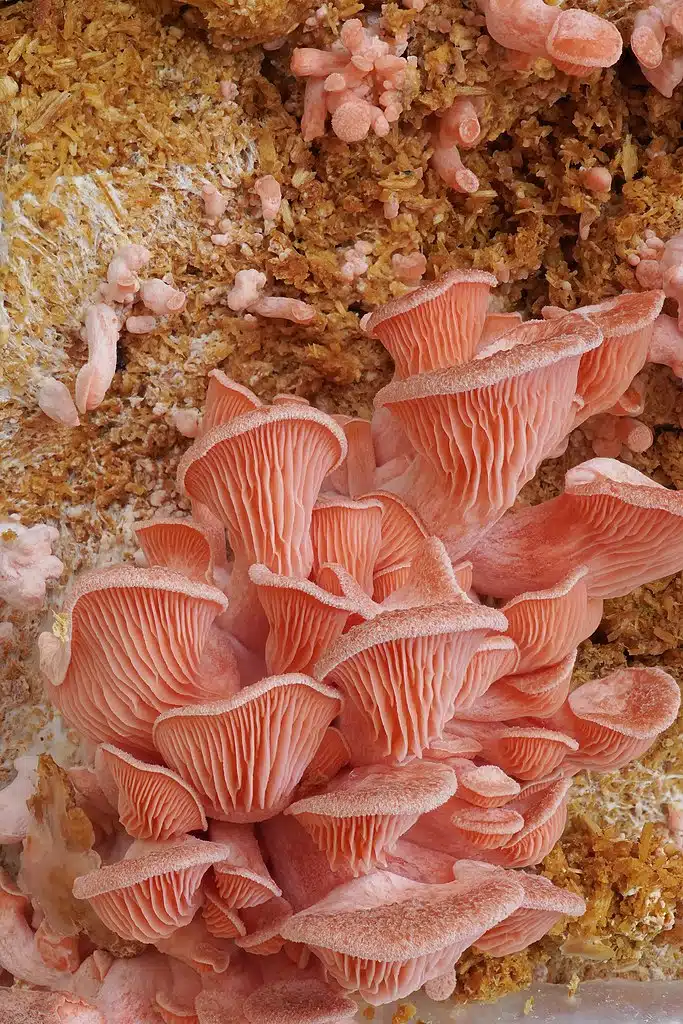
Pink nuance: bright pink
Pink Oyster Mushrooms (Pleurotus djamor) are some of the most widespread types of pink mushrooms in the world.
They grow on trees, look like oysters, and have a pink or salmon-pink color.
Central America marks the area where these mushrooms are the most common, albeit they are imported in other parts of the world due to their flavor.
These mushrooms are a bit chewy but they can be cooked in different ways.
A resemblance to bacon is what makes their fried taste even more popular. Once fried or boiled, their texture becomes more pleasant and highly edible.
Pink Oyster mushrooms may also be seen as a long-term meat replacement mushroom as their season expands from spring to fall.
Their high protein content and even meat-like taste also make them some of the tastiest pink mushrooms.
2. Bleeding Fairy Helmet
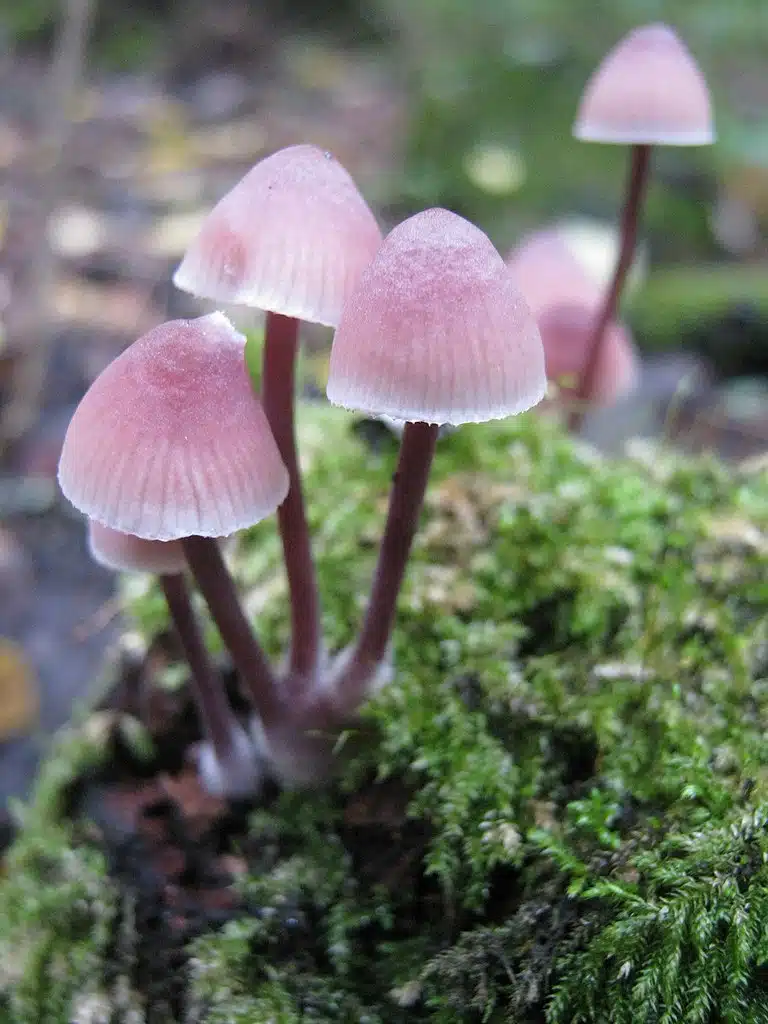
Pink nuance: bright to wine
Various nuances of pink, especially dark pink, as specific to the worldwide Bleeding Fairy Helmet (Mycena haematopus).
These mushrooms are small, barely growing up to a couple of inches but do tend to grow in clusters.
Preferred growing sites include decaying wood that’s been dead for a very long time in European, American, and Asian woodlands.
As they grow, these mushrooms can even darken but remain pink, mostly on their small caps.
These mushrooms are sometimes believed to be edible while official sources often warn to stay away due to lack of proof of their edibility.
Known for their vivid colors, they can eventually grow a white cap margin but the stipe of the species also brightens to a brighter type of pink.
Growing in small groups of up to tens of mushrooms, Bleeding Fairy Helmets are a more common species on old wooden homes around the world.
3. Coral-pink Merulius
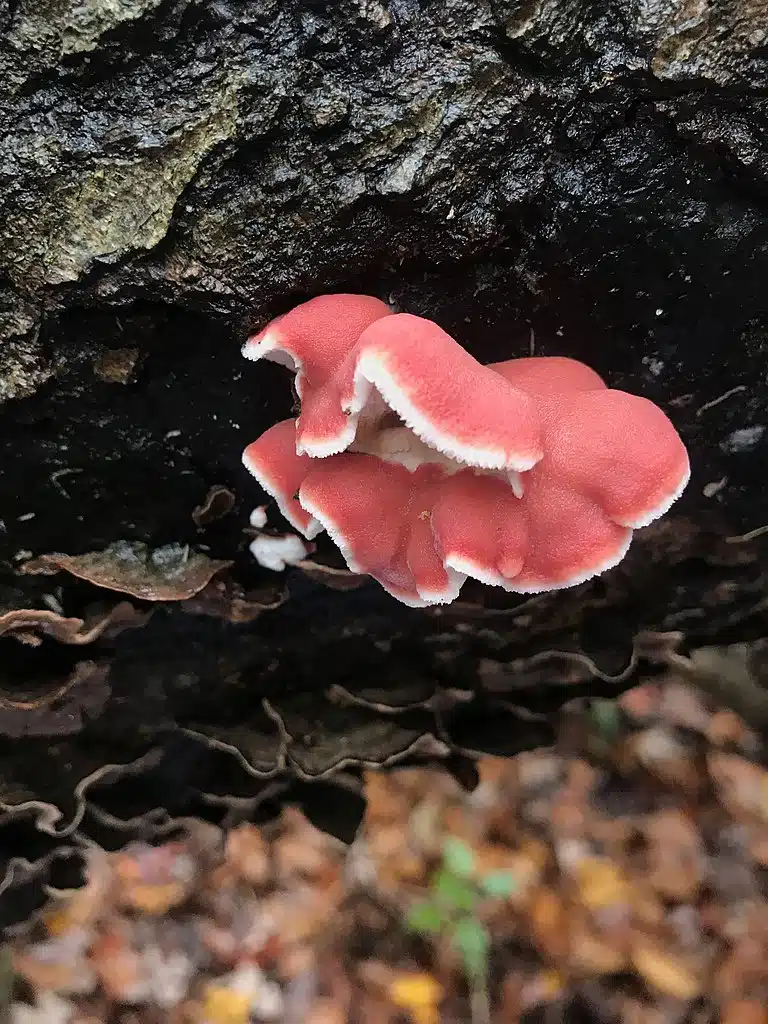
Pink nuance: bright pink, dark pink
Mostly bright pink, Coral-pink Merulius mushrooms (Phlebia incarnata) show darker pink edges with white margins.
They grow in layers across decaying trees, often covering them up, these mushrooms play an important role in the ecosystem as they help break down old trees.
Color patterns have reduced variations on the species with the exception of the older mushrooms which tend to darken on top but to remain bright on the bottom.
North and Central America mark the continents where these mushrooms grow, mainly in deciduous woodlands.
Growing without a stipe straight out of wood, Coral-pink Meruliuses aren’t edible and they may even be poisonous.
4. Pinkmottle Woodwax
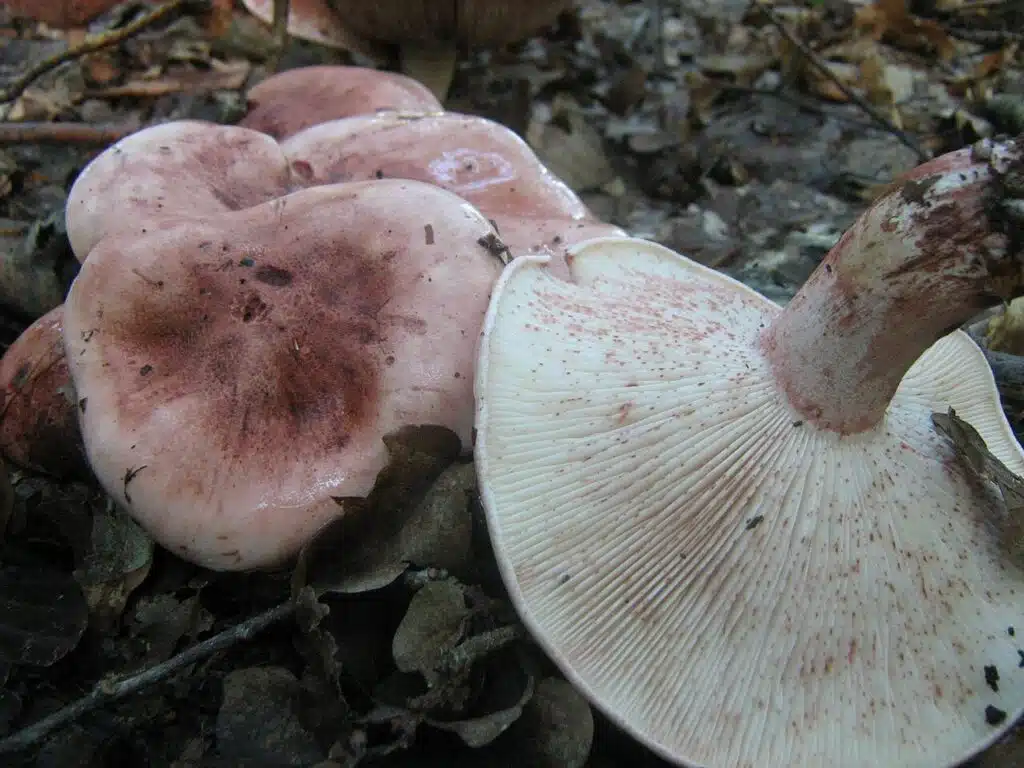
Pink nuance: bright pink
Pinkmottle Woodwax (Hygrophorus russula) is a type of large-cap mushroom with considerable pink coloring.
The pink color appears as a spotted pattern across the central area of the cap while its margins remain white.
Its stipe is mostly white with a few large pink spots as it grows.
The gills are white and pink-spotted. As the cap, the gills also have a wax-like texture to them.
Sometimes locally referred to as a type of False Russula, this type of mushroom isn’t as brittle.
It even grows in weird circles on lawns and in grassland, a growing pattern that has fascinated humans for centuries.
The species is mostly tied to oak woodlands where it begins to grow at the end of the summer.
Pinkmottle Woodwaxes are found across Europe and North America.
Its edibility status is still unclear. Edible by some sources, the mushroom is listed as not edible by others.
5. Mauve Splitting Waxcap
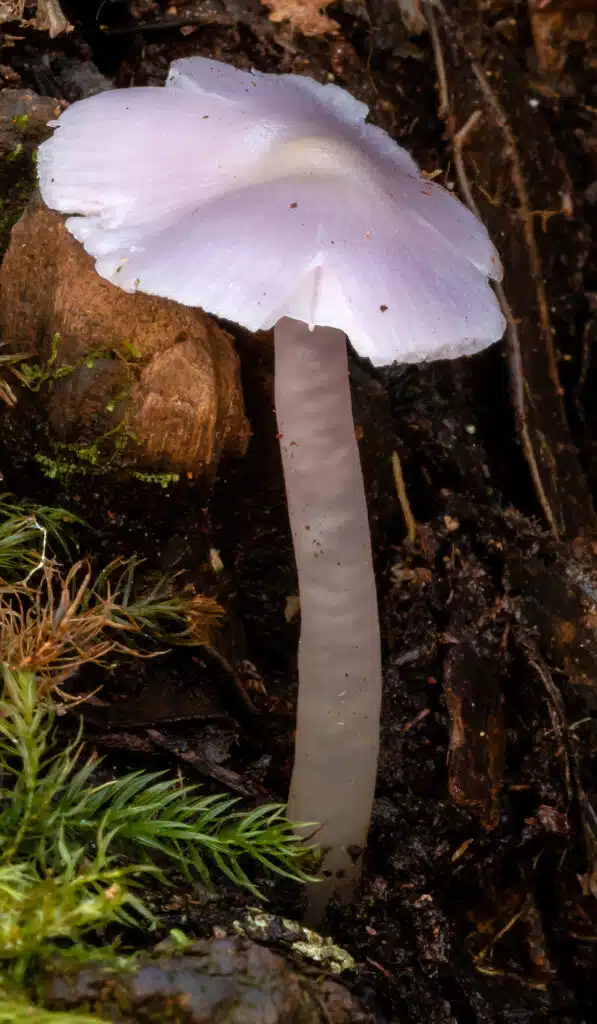
Pink nuance: pink-lilac
A darker pink nuance is specific to the cap of Mauve Splitting Waxcaps (Porpolomopsis lewelliniae). These mushrooms have a slight lilac nuance of a purple nuance to their pink colors.
The cap itself becomes flat and clearly visible. A typical cap diameter of 1-2 inches is mostly specific to these mushrooms.
A white stipe holds the small cap which tends to show a small bump in the central areas as it flattens out.
Mostly specific to the Southern parts of Australia, Mauve Splitting Waxcaps are also found in the woodlands of New Zealand.
Some of the notable exceptions of the species include growing on the beach.
These are among the few mushrooms that grow in tropical forests, subtropical forests, as well as in temperate forests.
6. Pink Domecap
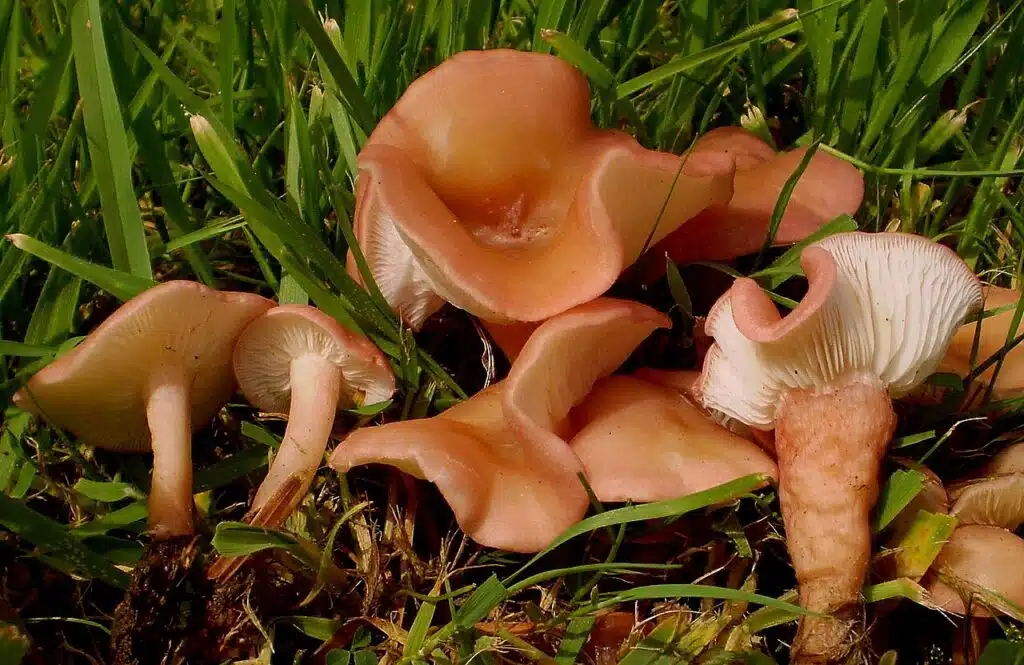
Pink nuance: pale pink
Various shades of bright pink are descriptive of Pink Domecap’s nuance of the cap.
This is a mushroom with faded pink nuances covering almost the entire flat cap which does show a few yellow dots on the margins as the cap flattens out.
Pink nuances are also seen on the lower half of the stipe as the upper part is mostly white.
Eventually, Pink Domecap mushrooms (Calocybe carnea) darken as they grow but there are exceptions as some of them remain bright pink even when fully grown.
A species present in Europe and The Americas, Pink Domecaps are primarily fond of grassland.
They aren’t as easily identifiable in Europe due to their scarcity but these mushrooms do enjoy at least a more common nature in regions of Asia.
Lawns are particularly attractive to the species which tends to grow in small clusters.
While it also grows in woodlands, it prefers grassy areas.
Pink Domecap mushrooms have been reported as edible but this changed over the past few years.
Mostly not picked due to its vivid color, this mushroom is also too small to be worth picking anyway.
7. Pink Bonnet
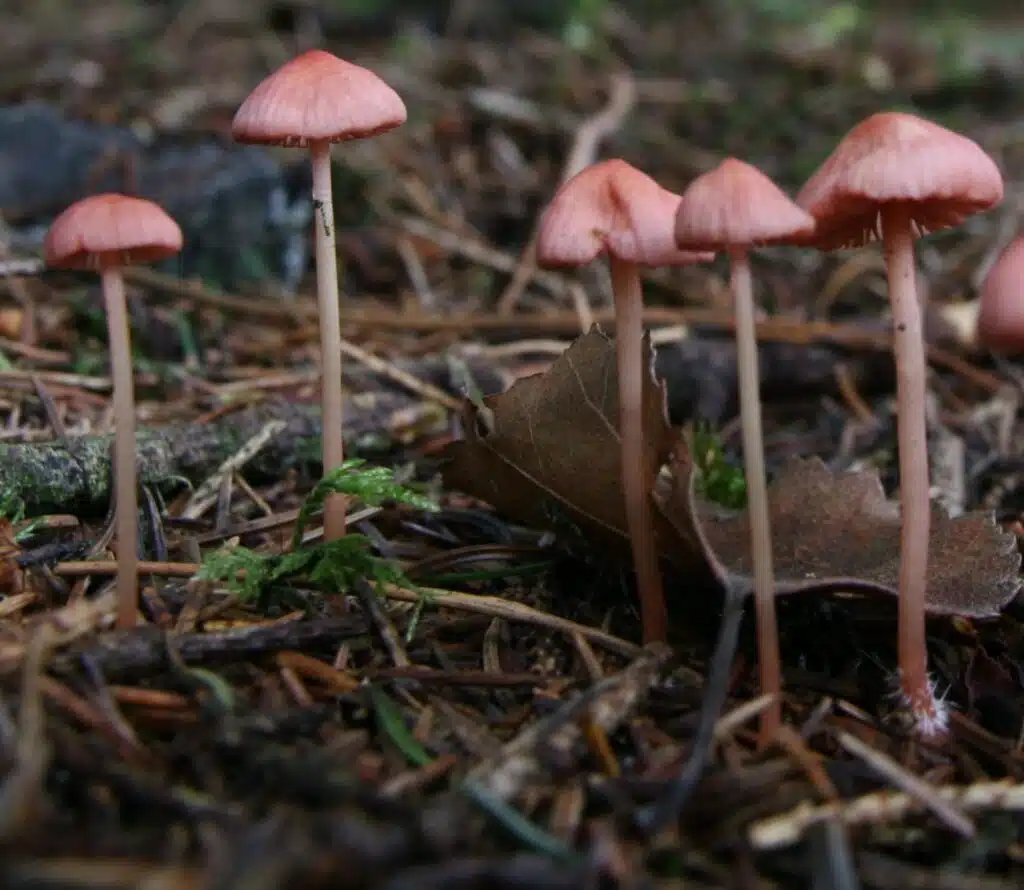
Pink nuance: bright pink, rose-pink
Thin and tall, Pink Bonnets (Mycena rosella) are named after the bright nuance of their bonnet-like caps.
While sometimes larger, these caps may also be as small as 0.5 inches in diameter.
They start with a bright pink nuance, slowly getting a rosy nuance to them as they grow. Both the cap and the gills have a bright pink characteristic appearance.
The stem of the species is thin and long. It doesn’t taper and maintains a pale pink nuance throughout its growth stages.
A species growing in larger numbers under beech, Pink Bonnets are mostly known for growing in clusters.
Tens of mushrooms can grow together in a small location in the woodlands and be completely absent from other areas.
Sometimes also found in coniferous woodlands, the mushrooms are believed to be poisonous, although they haven’t been properly tested.
This is also a species that grows late into the season in temperate woodlands. Some Pink Bonnets even grow in early November.
Some of the distinct traits of the later-season mushrooms include a convex cap that doesn’t flatten out. Central sections on these mushrooms can also be brighter pink later in the season.
8. Rosy Woodwax
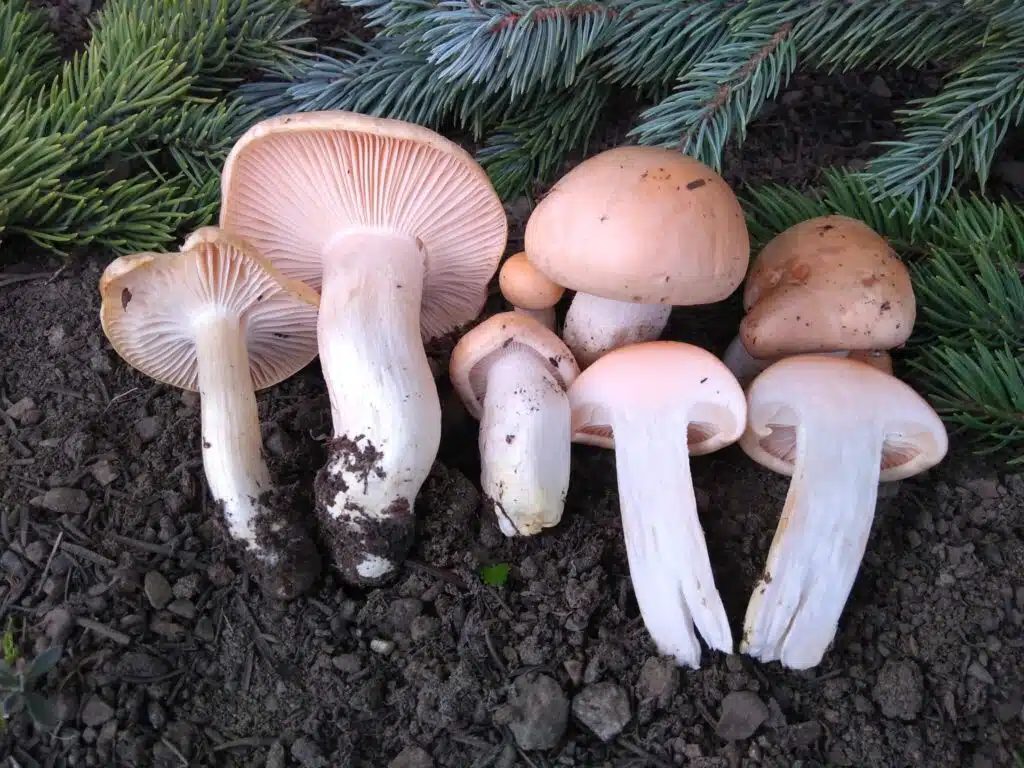
Pink nuance: pink-gold
A rare type of pink-gold nuance is seen on the caps of Rosy Woodwax mushrooms (Hygrophorus pudorinus).
This species tends to get a slight orange nuance towards its later growth stages. Its colored appearance is further seen in its red bruising.
Rosy Woodax mushrooms can be edible after thorough cooking.
The problem with the species and with other mushrooms that change colors frequently as they grow is with correct identification.
People may not be able to correctly identify Rosy Woodwax mushrooms and this is why they aren’t recommended to be picked.
They do tend to grow in clusters, which makes them easier to spot.
Mostly growing under spruce, Rosy Woodwax mushrooms are known for their North American presence on the Western side of the continent.
From California to Western Canada, these mushrooms are a confirmed presence in late summer and early fall.
9. Pink-capped Oak Butter Bolete
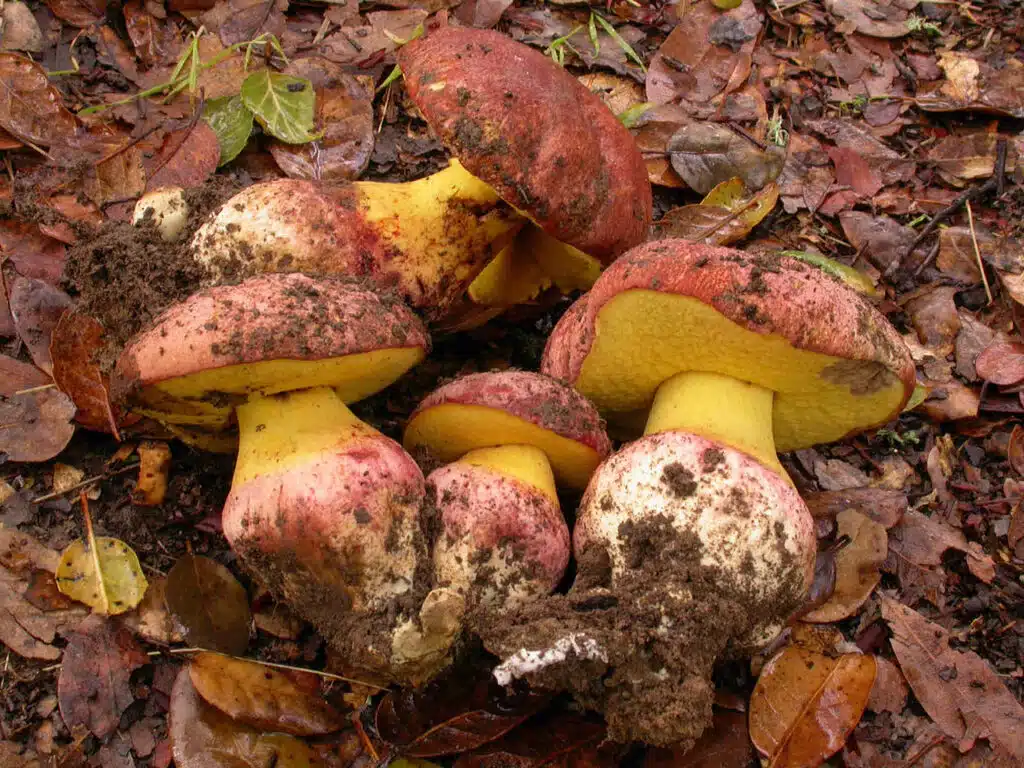
Pink nuance: pink, dark pink
As one of the largest types of pink mushrooms, The Pink-capped Oak Butter Bolete (Butyriboletus querciregius) is a species known for its top flavor.
Picked by those who know to avoid similar poisonous mushrooms, Pink-caped Oak Butter Boletes end up in fine restaurants.
These types of mushrooms are identified by their dark pink cap with pink-red nuances in the central areas of the cap.
It shows cream or yellow spores and stipe coloring. The thick stipe of the species is specific to some of the most flavorsome mushrooms that grow lose to oak.
Found both in European and North American forests, this is a species that grows in California, in The US.
While large, it’s still a species that grows solitary.
10. Rosy Brittlegill
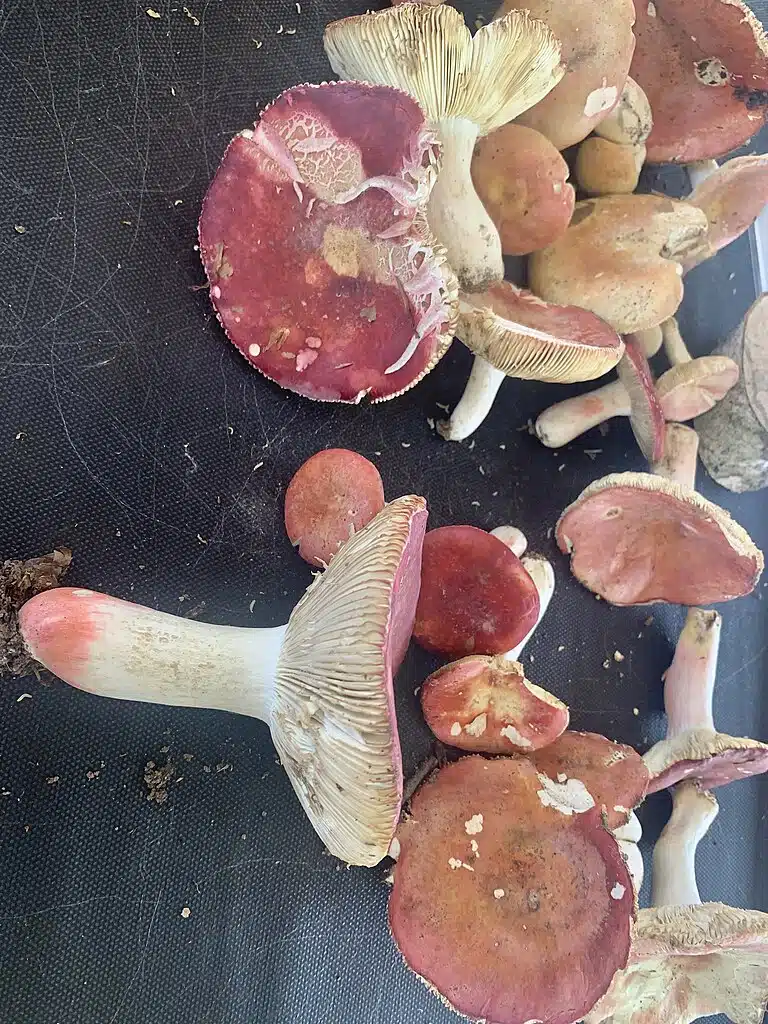
Pink nuance: pink-red
Darker pink nuances cover the cap of Rosy Brittlegill (Russula rosea). This is a species with a darker inner part of the cap and a brighter pink cap on the margins.
As it flattens, the cap of Rosy Brittlegills has a lower inner section as well.
Its gills are white and fragile while the wide stem of the mushroom is also white.
In its later growth stages, pink sections may also appear on the upper part of the stipe.
Growing to a diameter between 2 and 4 inches, Rosy Brittlegill mushrooms are associated with coniferous woodlands first.
On occasion, they may also grow under beech.
By some sources, the mushroom is edible while others warn against it. Rosy Brittlegills are said to have a forest almost wood-like flavor.
11. Apricot Jelly
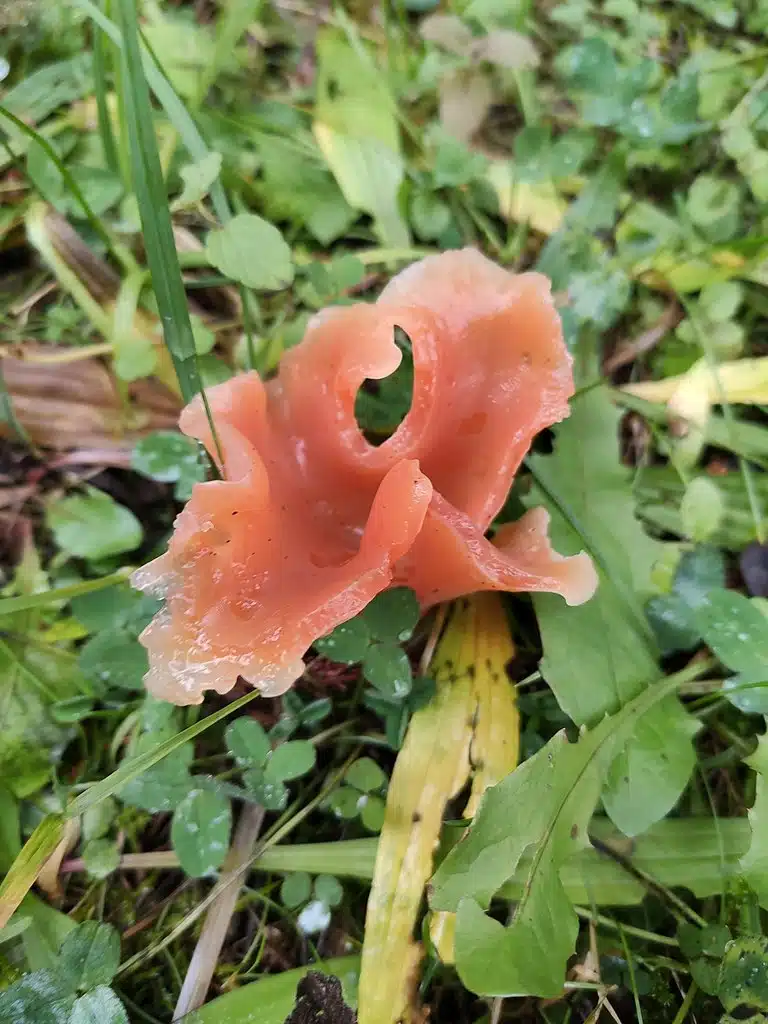
Pink nuance: salmon-pink
Apricot Jelly fungi (Guepinia helvelloides) come in different colors, including a pink nuance, an apricot nuance, and a bright orange nuance according to their growth stage and location.
Also found in The United States, Apricot Jellies grow in the Northern and Eastern coniferous woodlands.
They prefer old and new woodlands, as long as there’s rotting wood or organic matter for them to feed on.
Quite large when fully grown, Apricot Jelly fungi can reach a height of almost 7 inches.
These types of fungi are considered edible, unlike many others that look like them.
Some of the main uses of the species include raw food combinations such as salads.
A rather rubber-like texture keeps these fungi from becoming a popular choice in the retail space as well.
12. Yellow-staining Milk Cap
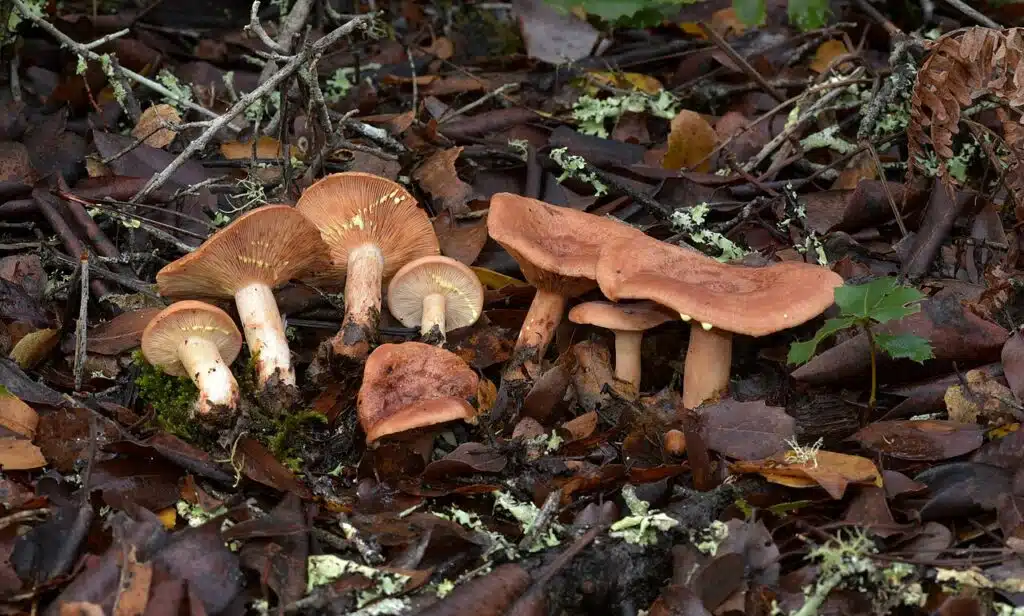
Pink nuance: pink-cinnamon
A species of North American, Yellow-staining Milk Cap mushrooms (Lactarius xanthogalactus) are named after the color of their oozing liquid.
Yellow liquid drops start to come out of its gills when damaged.
This thick liquid has the texture of latex and inspires the name of the mushroom.
Forests in Eastern and Western North America are home to this species. Both coniferous and hardwood forests are places with confirmed growth.
This species shows a dark pink cap which gets even darker and cinnamon or brown-nuanced as it grows.
With a cap size between 2 and 4 inches, this species starts to darken over time.
This darkening nature is also spotted on the white stipe which also becomes pink-cinnamon as it grows.
While large, the species does grow in clusters of up to 10 mushrooms under trees.
13. Rosy Navel
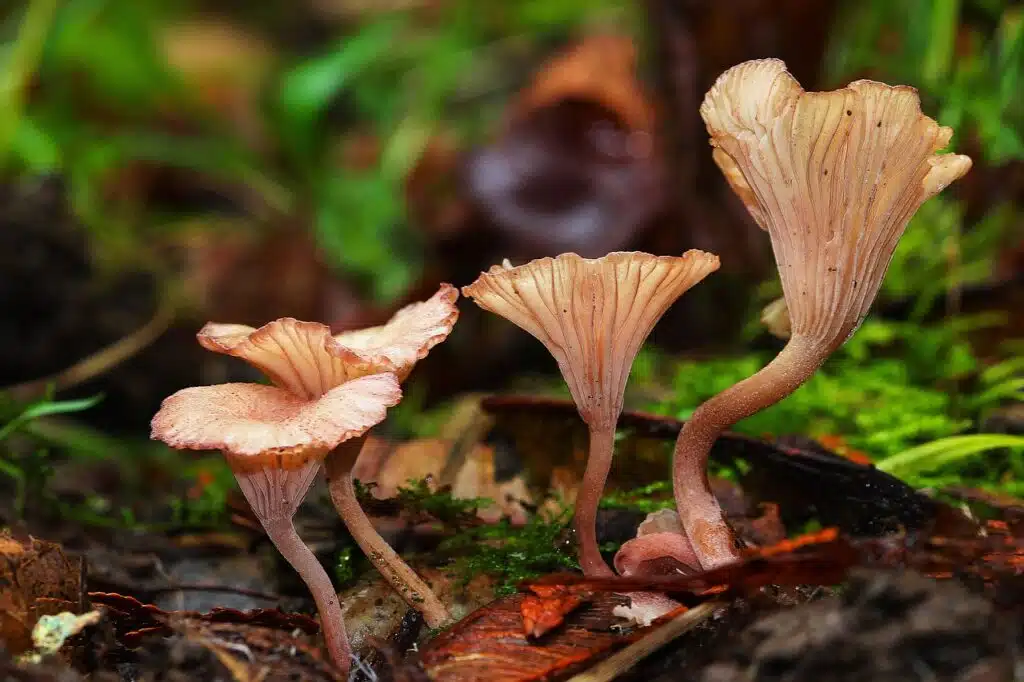
Pink nuance: pink, yellow-pink
As Yellow-staining Milk Cap Mushrooms, Rosy Navel mushrooms (Contumyces rosellus) are also found both on the East and on the West coasts of The United States.
This is a species that shows a bright nuance at first, close to yellow. It then turns pink or partly pink with intermediary yellow-pink nuances.
When fully grown, they show a yellow cap with pink edges and a yellow-pink stipe.
A rather small mushroom, Rosy Navels may show a cap diameter of under 1 inch even when fully grown.
Some of the ideal places for the species to grow include sandy areas along the coast.
Beaches may only be a feasible place to grow when there’s plenty of decaying vegetation and decaying trees for these mushrooms to feed on.
Rosy Navels tend to grow in very large numbers, even covering an area in their hundreds.
14. Wrinkled Peach
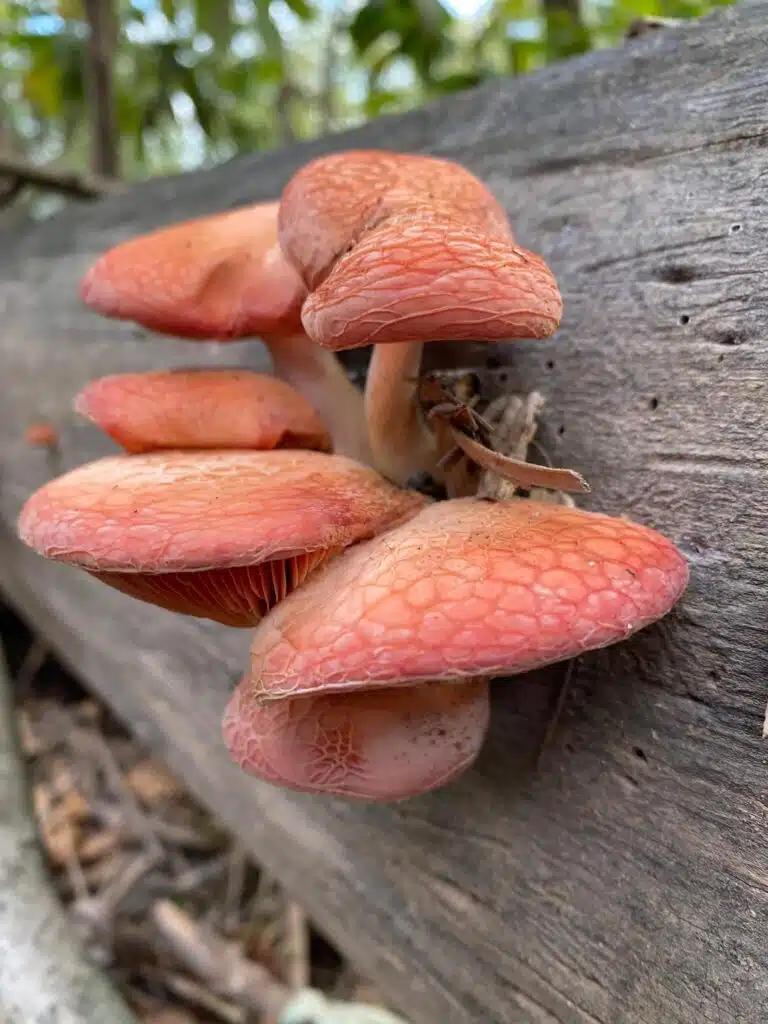
Pink nuance: peach-pink
Rotting trees around the world are the ideal microhabitat for Wrinkled Peach mushrooms (Rhodotus palmatus).
These types of mushrooms grow in Africa, North America, and Europe.
A peach-pink nuance is mostly specific to the cap.
Initially globe or egg-shaped, these mushrooms grow into a peach-pink cap color with a ridged appearance.
Various types of decaying trees prompt the growth of the species in large numbers, according to its location.
Some of the hardwoods it grows on in North America include elm while its European counterparts may favor other species.
Largely considered not edible, the species has a rubbery cap. It has a bitter taste according to some sources while others claim it has a sweet flavor.
15. Lilac Bolete
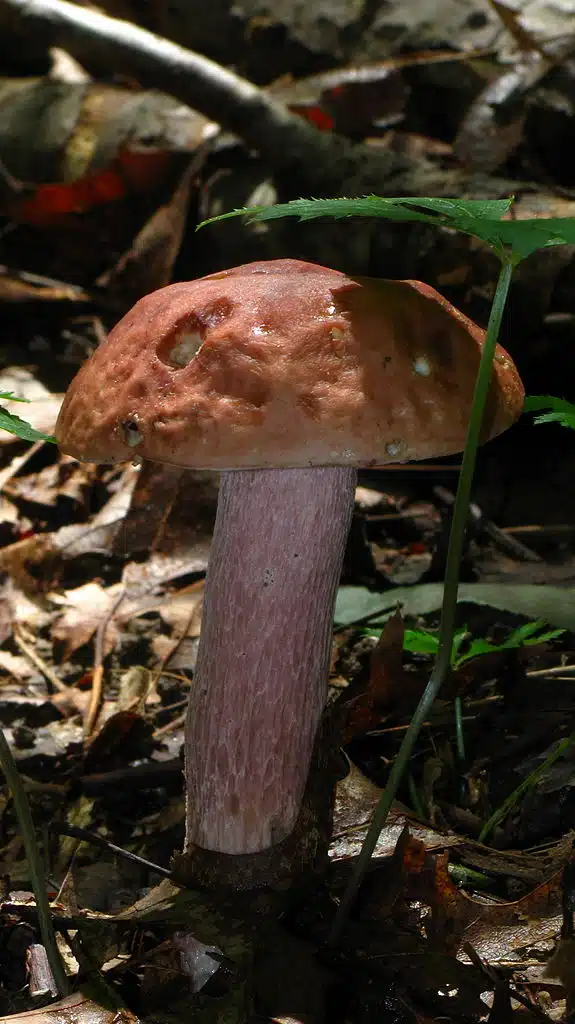
Pink nuance: pink-magenta
Pink, purple, and brown nuances are spotted on Lilac Boletes (Boletus separans).
These mushrooms have an initial darker pink nuance to eventually grow into purple-brown mushrooms with a pale pink stipe.
A cap and stipe of this nuance aren’t rare in the world of mushrooms but the yellow pores confirm its identity.
Lilac Boletes don’t have gills like other mushrooms.
This type of mushroom grows to a tall size of up to 4 inches.
It grows in deciduous woodlands of the world, including in North America.
Many states East of The Rocky Mountains are places where the mushroom grows, typically scarcely.
16. Cluster Cap
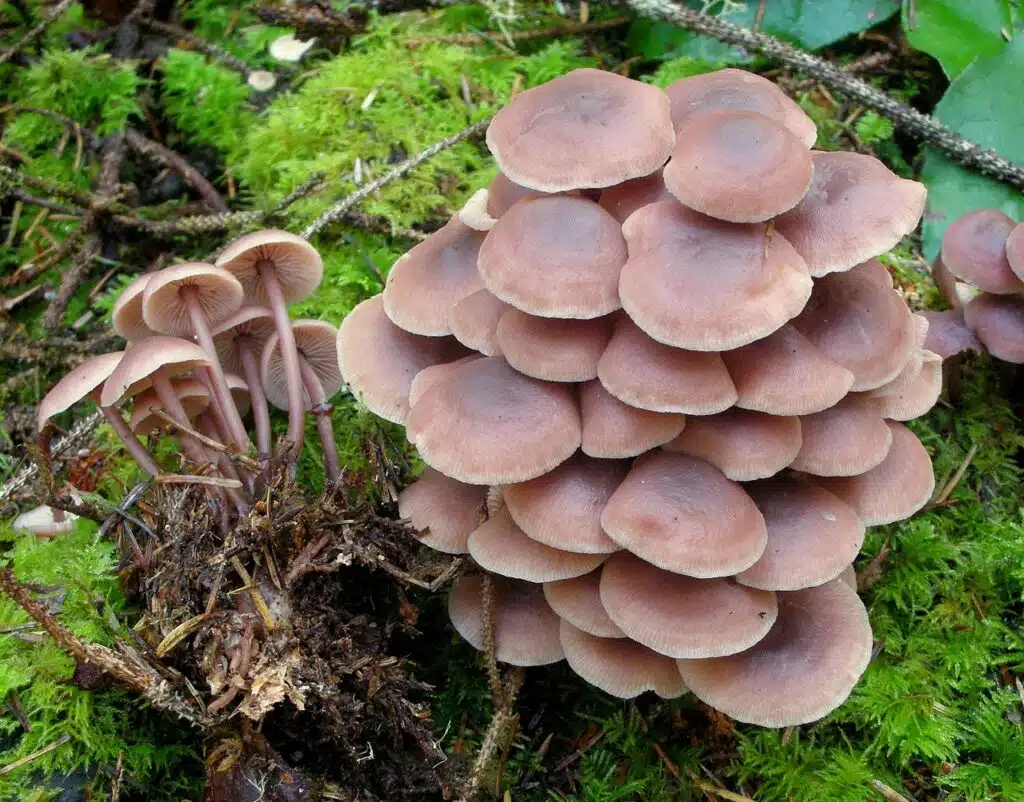
Pink nuance: pink-purple
Growing in bouquet-like clusters, Cluster caps (Connopus acervatus) are among the few types of mushrooms that brighten as they grow.
Initially brown, they slowly turn pink or pink-brown. The colorful cap of the species flattens and even becomes wavy as it grows.
Even at a maximum growth stage, Cluster Cap mushrooms have a cap diameter between 0.5 and 2 inches.
Brittle white gills are characteristic of these mushrooms while the stipe remain brown through their growth stages.
Cluster Caps are tied to decaying wood and are found across Europe and North America.
17. Pink Waxcap
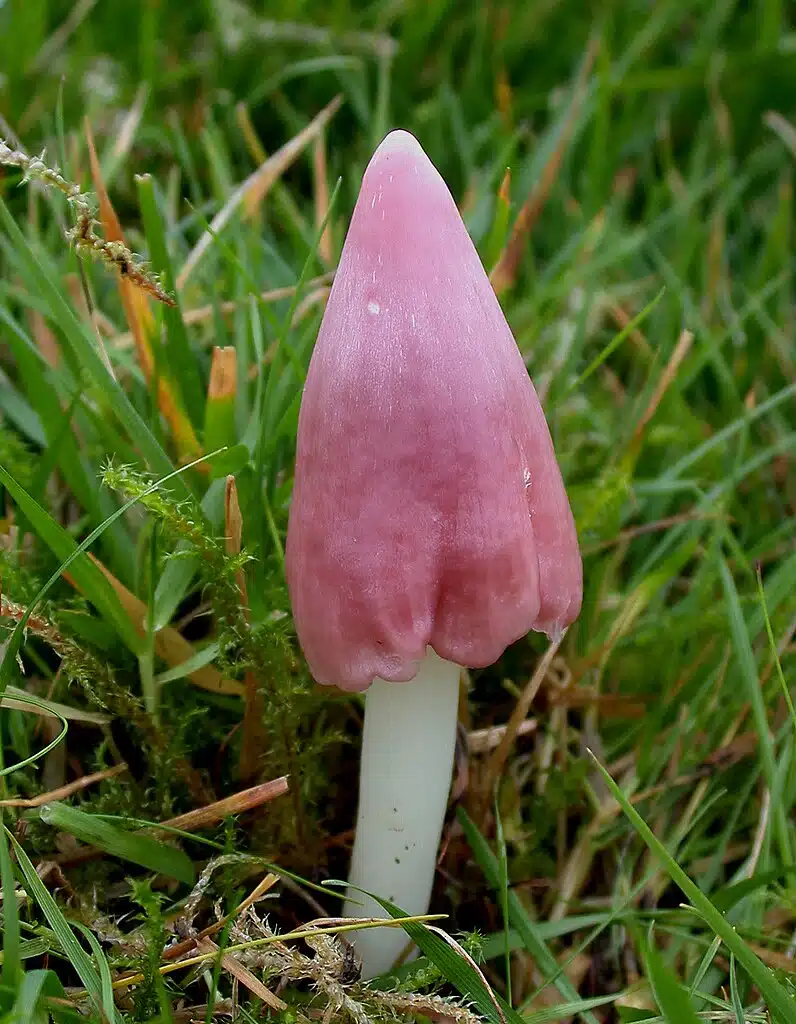
Pink nuance: pale pink
One of the rarest types of pink mushrooms in the world is Pink Waxcaps (Porpolomopsis calyptriformis). They have a very bright pink nuance and they also appear white in their early growth stages.
The cap becomes bright pink while the stem remains white through the growth stages.
Mostly a species of Europe, Pink Waxcaps are types of mushrooms that prefer grassland.
Only undisturbed grassland that hasn’t been affected by agriculture is suitable for the species.
Scarce in mainland Europe, the mushroom is mostly found in Britain and Ireland.
While edible, it may not be worth picking given it grows scarcely and may be difficult to find.
18. Rosy Bonnet
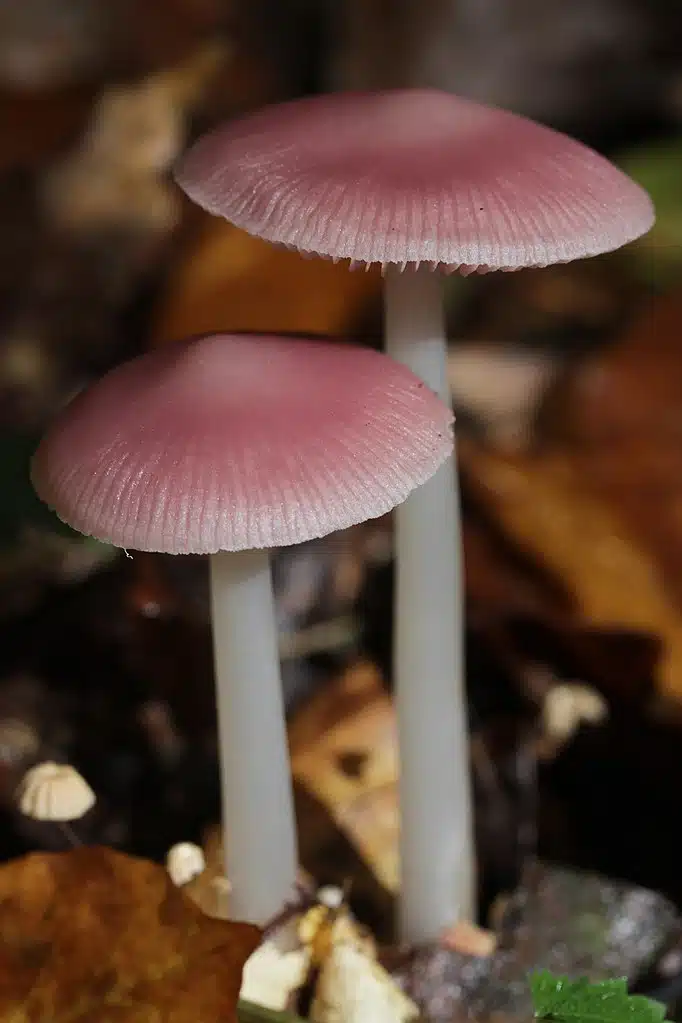
Pink nuance: bright pink
Bright pink caps with a central white or yellow spot are specific to Rosy Bonnets (Mycena rosea).
These mushrooms also show a cap flattening tendency with time, but the main color remains pink.
A white stipe is further specific to these mushrooms.
While bright and colorful, Rosy Bonnets are mostly specific to coniferous woodlands.
These types of mushrooms grow under various species of pine.
Clearly not edible, Rosy Bonnets may also prove poisonous so it’s best not to pick them,
19. Mauve Elfcup
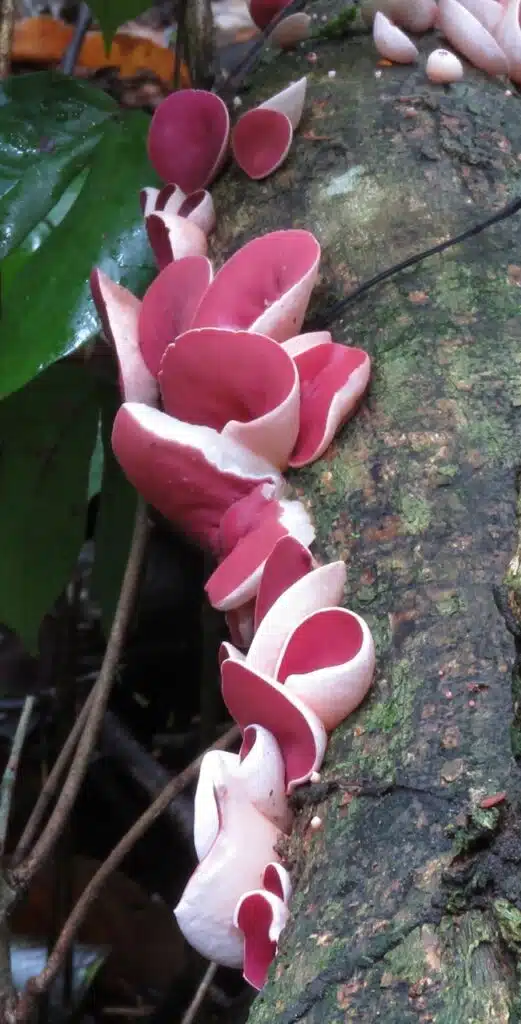
Pink nuance: pink-purple
Dark vivid pink is specific to the Mauve Elfcup species.
This cup-shaped fungi even has salmon-pink flesh. Its top fruiting bodies have a darker pink nuance throughout its growth stages.
White is specific to the underside of the fungi.
Mauve Elfcups (Phillipsia domingensis) are mostly seen on dead wood where they can grow in small groups of 2-4 fruiting bodies or in large groups of up to hundreds of fungi,
Its final size may be within the 2-4 inch range.
Deciduous woodlands of the world are the ideal habitat for decaying trees and the high humidity these mushrooms need to thrive.
20. Hintapink
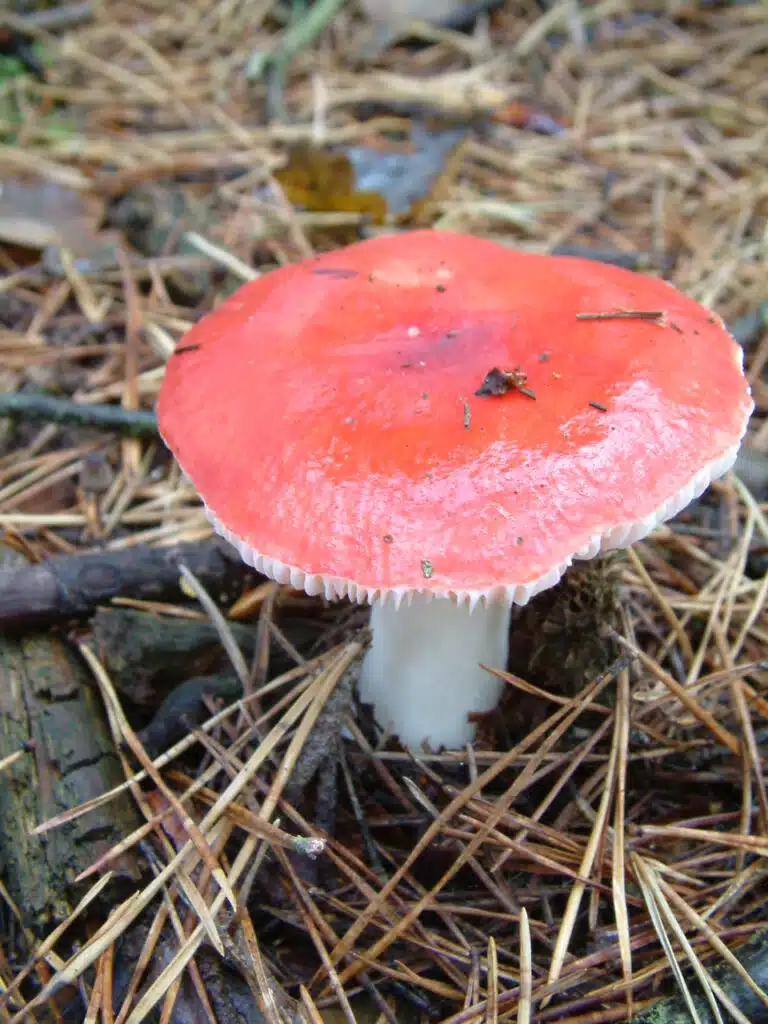
Pink nuance: pink-red
One of the important edible pink mushrooms of the world is Hintapinks (Russula paludosa).
These are also some of the largest edible pink mushrooms as a typical cap may grow to a diameter of 3 – 4.7 inches.
The species is found in woodlands, like most pink mushrooms.
Unlike other pink mushrooms, Hintapink doesn’t have a single type of cap appearance.
While mostly pink in most cases, these types of mushrooms may also show a different central cap color.
A yellow central cap is the most common variation of an all-pink cap. In addition, orange central sections are also confirmed on the caps of this species.
A short season means these temperate forest pink mushrooms tend to be in high demand even though they do not have a very distinct taste.
Hintapinks grow at the beginning of the fall and are believed not to have a particular smell or taste.
21. Fatal Dapperling

Pink nuance: pink-brown
Pink-brown nuances are specific to Fatal Dapperlings (Lepiota subincarnata). Both the cap and the stipe show this nuance, but the stipe is mostly white.
Picking and eating these mushrooms is not advised due to their fatal reactions.
As one of the most poisonous pink mushrooms in the world, Fatal Dapperlings typically kill a person within a week, mostly due to renal failure.
Some fatalities may occur due to these mushrooms being confused with other dapperling mushrooms.
Eventually mostly red-brown on the cap as they reach their peak growth stage, the mushrooms are also encountered over a long period in woodlands from summer to fall.
Other species of dapperling mushrooms are also fatal and may be confused with Fatal Dapperling.
Among them, there’s The Deadly Dapperling (Lepiota brunneoincarnata).
This is also a slightly pink mushroom but with a dominant brown-pink nuance.
Similar in color but darker, this is also a similar-sized species.
Dapperlings mushrooms, in general, are believed to be quite similar in appearance and may not even be worth picking as few aren’t poisonous.
22. Maroon Madrone Tubaria
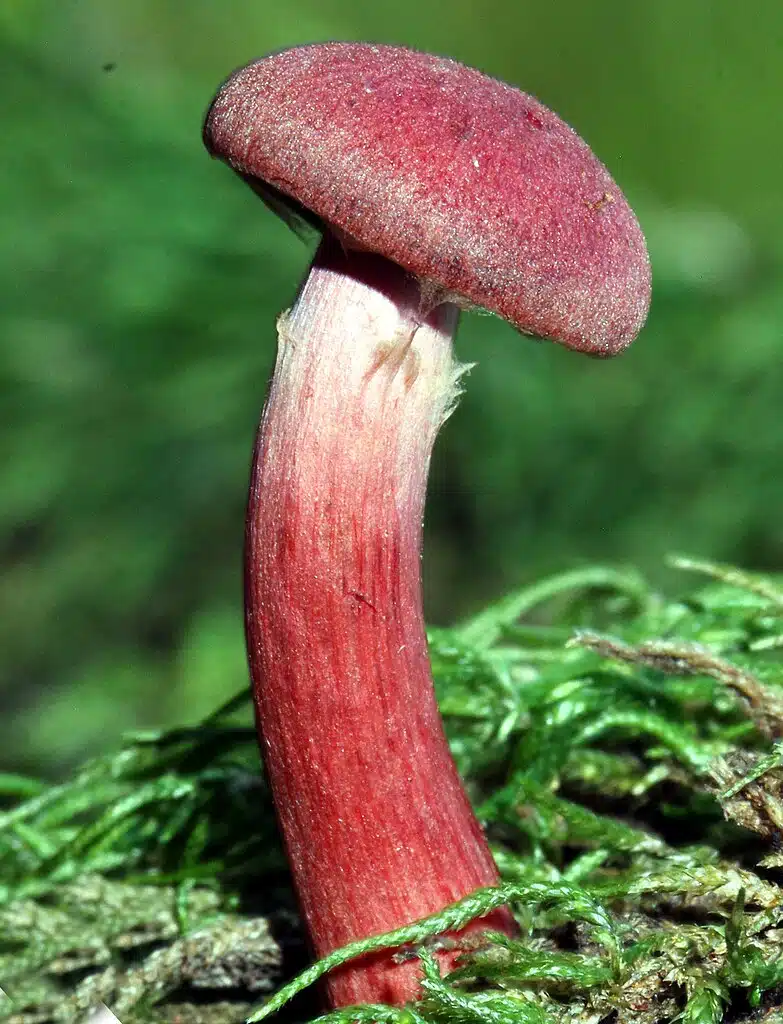
Pink nuance: pink-red
Dark pink that turns into red-pink is specific to Maroon Madrone mushrooms (Tubaria punicea). The cap is the darkest, showing red-to-purple nuances in its later growth stages.
The stipe has a darker red nuance at the bottom, a brighter red nuance in the middle, and a pink nuance towards the top before turning white in the area closest to the cap.
Woody debris and woodlands of North America are areas where these mushrooms grow.
Mixed pine and oak forests from Western Canada down to California are their most common habitats.
Unlike many other species, Maroon Madrones mostly grow in tree cavities or rotten areas of trees.
A hardwood or coniferous tree that has also been damaged in a storm may also prompt the growth of these mushrooms in the areas most affected by the storm.
As a result, the growth location of the mushrooms also impacts their final color.
Some may be pink-red, red, maroon, reed, or maroon altogether.
Among all of these color variations, there’s the constant of the brighter gills which are often pink.
Furthermore, spotting these mushrooms in their hundreds is a common sight due to their rapid spread.
23. Birch Brittlegill
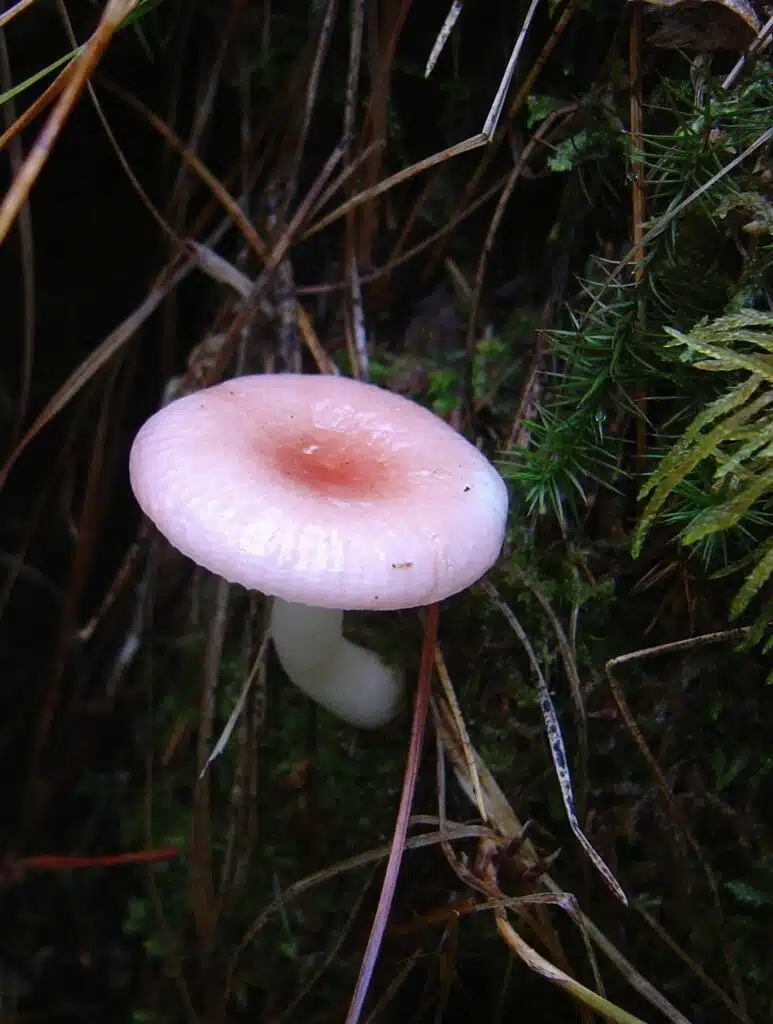
Pink nuance: pale pink
A very pale pink nuance may even make it seem like Birch Brittlegill mushrooms (Russula betularum) are all-white when not inspected up close.
This species is mostly found in Northern Europe where it grows in mixed woodlands.
Not as common in mainland Europe, these mushrooms grow in the highest numbers across Scandinavian woodlands.
Its pink hue caps are seen later in its growth stages. The flattening-out white cap shows pale pink nuances mostly on the margins while the stipe remains white throughout its growth stages.
Mostly associated with birch trees, Birch Brittlegills only grow around birch.
With a peppery taste, these mushrooms are not edible.
Confusion is specific to correct identifications of the mushrooms.
Most commonly, they may be confused with other types of poisonous mushrooms such as the similar in size but darker Emetic Russula.
24. Beechwood Sickener
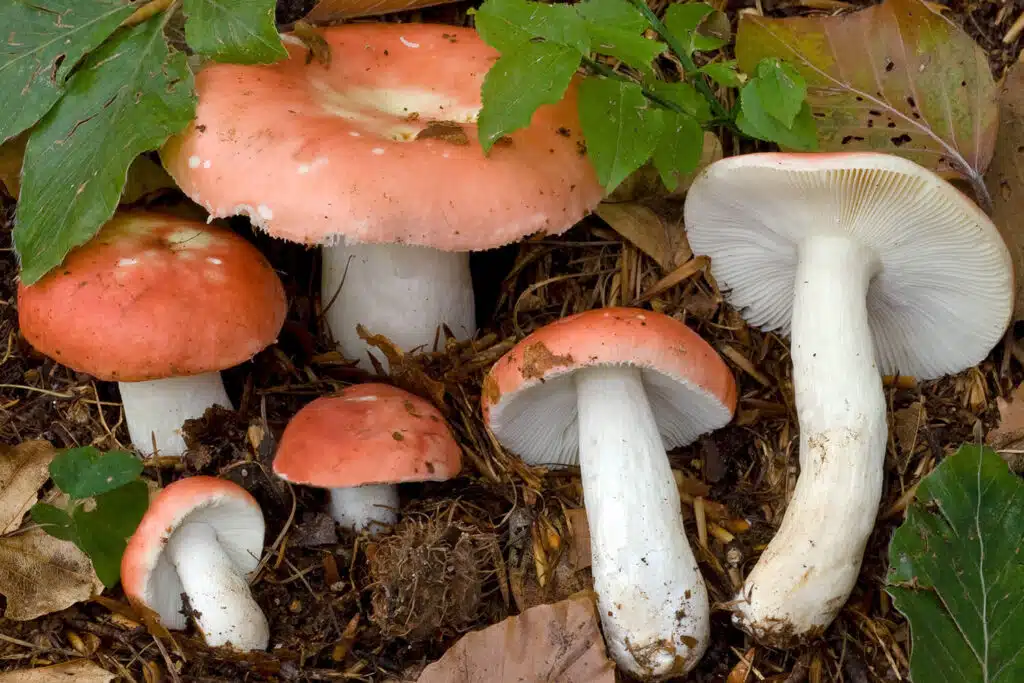
Pink nuance: pink-red, bright pink
Variable pink nuances decorate the cap of Beechwood Sickeners (Russula nobilis).
These nuances vary considerably but are contrasted by a white stripe.
Also associated with beech, these mushrooms are poisonous but aren’t believed to be fatal to humans.
While boiling or frying these mushrooms may reduce toxicity levels, it’s still best not to pick them.
Most toxicity-related symptoms are specific for people who ate raw Beechwood Sickeners.
Symptoms such as vomiting and nausea are described in these cases but it’s unclear if the same symptoms are specific to those eating cooked Beechwood Sickener.
Also growing in North America, Beechwood Sickener is widespread in Europe.
While highly poisonous to humans and animals, these mushrooms are believed to be beneficial to beech.
The trees next to these mushrooms rely on the fungi for minerals which help them grow.